Environmental alarm bell, artwork or both? With a team of scientists, artist Kelly Jazvac makes a newly discovered ‘rock’ art’s latest Readymade.
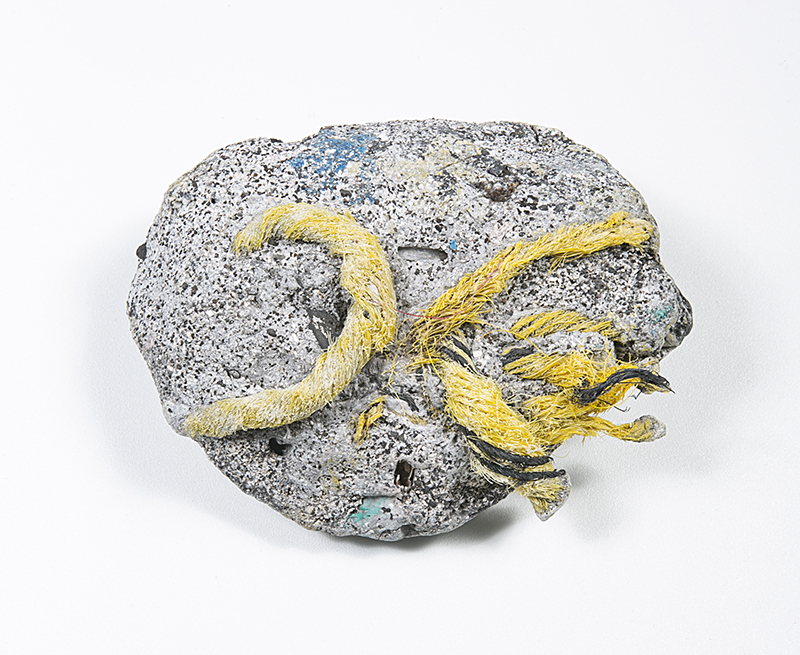
But if I see before me the nervature of past life in one image, I always think that this has something to do with truth. — W. G. Sebald, After Nature 1
The seminal French artist Marcel Duchamp was, among other things, a trickster par excellence. Drawn into the Dada movement’s embrace of absurdity, rejection of Nationalism, and assault on tradition, Duchamp culled from the world around him, making art from everyday found objects. From these he would create “readymades”: already-made, mass-produced or manufactured stuff transformed into “art” simply because he, as an artist, said it so. While many people recognize Fountain (1917), a porcelain men’s urinal flipped on its back, signed “R. MUTT,” and placed in an art gallery, Duchamp’s first readymade was created in 1913 under the title Bicycle Wheel. Here, Duchamp mounted a metal bicycle wheel onto a painted wooden stool; however, that one simple gesture changed everything. His statement on the marriage of materials was as much aesthetic as it was prophetic: “I had the happy idea to fasten a bicycle wheel to a kitchen stool and watch it turn.”2 By combining common industrial materials to produce a sculptural object, Duchamp completely redefined just what art, design and craft really is.
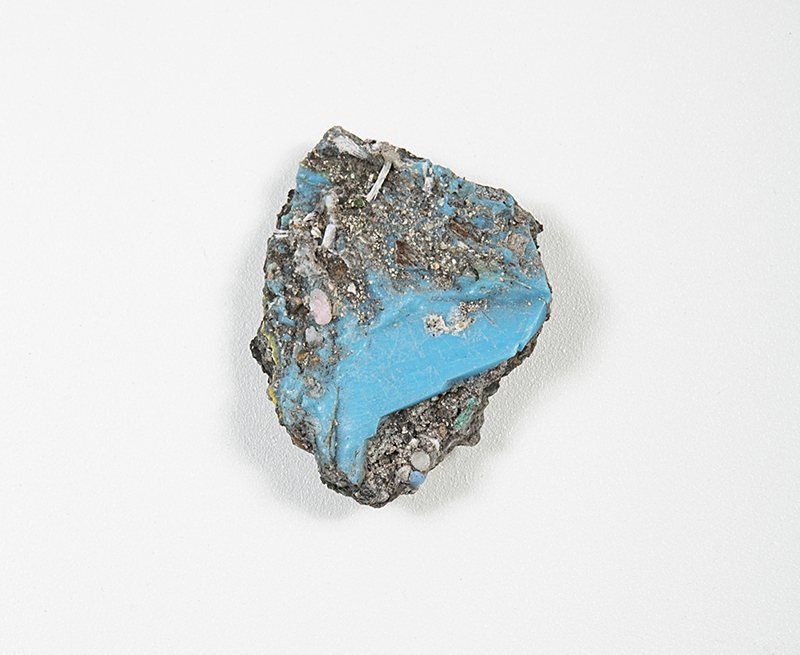
Exactly 100 years after Duchamp’s radical innovation, a readymade of a more sinister variety, found on the quiet shores of Kamilo Beach, Hawaii, was studied and described. There, common mass-produced plastics melt into naturally occurring matter including sand, volcanic rock and coral to produce a substance known as “plastiglomerate.”
London, Ontario-based visual artist and Western University Professor Kelly Jazvac has recently displayed plastiglomerate as readymade art objects at SECCA in North Carolina; Art Museum at the University of Toronto; Carleton University Gallery in Ottawa; Projekstrom Normanns in Norway; Louis B. James Gallery in New York; and Oakville Galleries’ Gairloch Gardens. Jazvac has employed salvaged plastics, the readymade, and other mass-produced materials, including Plexiglas and cardstock, in her rich body of work since 2005. However, she first embarked on this new direction of research after Western University Earth Sciences Professor Dr. Patricia Corcoran invited noted oceanographer Charles J. Moore of the Algalita Marine Research Institute in Long Beach, California to speak publicly on plastics pollution at the university in 2012.
Moore presented a slide featuring a strange brew of plastics bound together with natural materials from Kamilo Beach. As of then, it did not yet have a name, nor was there a clear understanding of how it was formed. Moore’s hypothesis was that lava from nearby volcanoes was in fact melting plastics washed ashore on the beach and, therefore, nature itself rather than the human population was remedying its own pollution problem.
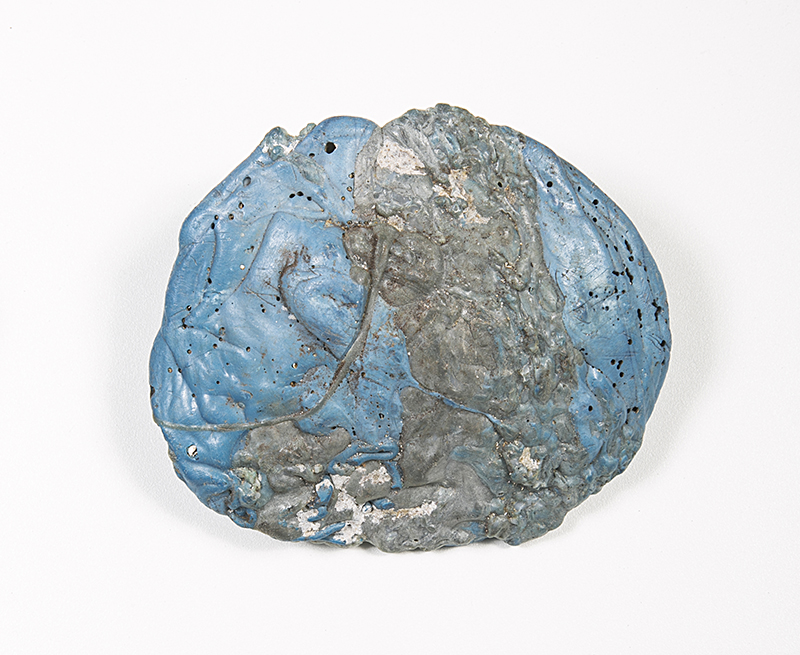
Soon after Moore’s lecture, Corcoran and Jazvac traveled to Kamilo Beach to investigate the phenomenon for themselves. In exchange for paying her own way to the site, Jazvac was given the opportunity to pursue the research as a visual art project.3 What they encountered was devastating: a new type of stone formed through an intermingling of melted plastic, beach sediment, basaltic lava fragments and other organic debris.4 Further, plastiglomerate’s making was clearly quite banal, and very human: people having bonfires on a beach littered with a remarkable amount of plastic debris is what created plastiglomerate—not lava. Although the lava version of the story is certainly more exciting, Corcoran and Jazvac began to discuss and consider the cultural implications of these findings; the result of which was a scientific manuscript that is drawn from their scientific data, but also contains a speculative component drawn from their dialogue.5
According to the findings of their research, published by the Geographical Society of America, plastics are essentially synthetic organic polymers used in mass-produced consumer goods that hold potential to break down mechanically, chemically or, to a lesser degree, biologically over hundreds or even thousands of years. It happens that Kamilo beach is enveloped with small plastics debris known as “plastic confetti,” which litters the land, vegetation and sand in a rainbow of over-consumption, a metaphor for our times.
Corcoran, Moore and Jazvac suggest that the beach’s proximity to trade winds makes it an ideal venue for waste pollution:
Given the beach’s constant exposure to the northeasterly trade winds, much of the small (<10 cm), lightweight plastic debris is blown to the back-shore environment, where it becomes trapped in vegetation. On a beach as dynamic as Kamilo, preservation of plastics in the sediment column could occur where trapped sediment is covered with sand or where a polymer is combined with a much denser material. We observed the results of this density increase on Kamilo Beach, where great quantities of melted plastic have mixed with the substrate to create new fragments of much greater density, herein referred to as “plastiglomerate.”6
The mixing of plastics with substrate is a direct product of bonfires that occur, rather “naturally”, on sites of the beach dirty with plastic confetti, as well as larger pieces of plastic debris. Not only does the fire melt the plastic into crevices of the substrate, but it also releases toxins directly into the air. That being said, Corcoran indicates that the presence of plastiglomerate is not confined to Kamilo Beach but occurs somewhat naturally in other beaches and shores throughout the world; though, these instances have yet to be reported or to be named as we are still in the early stages of its appearance.7
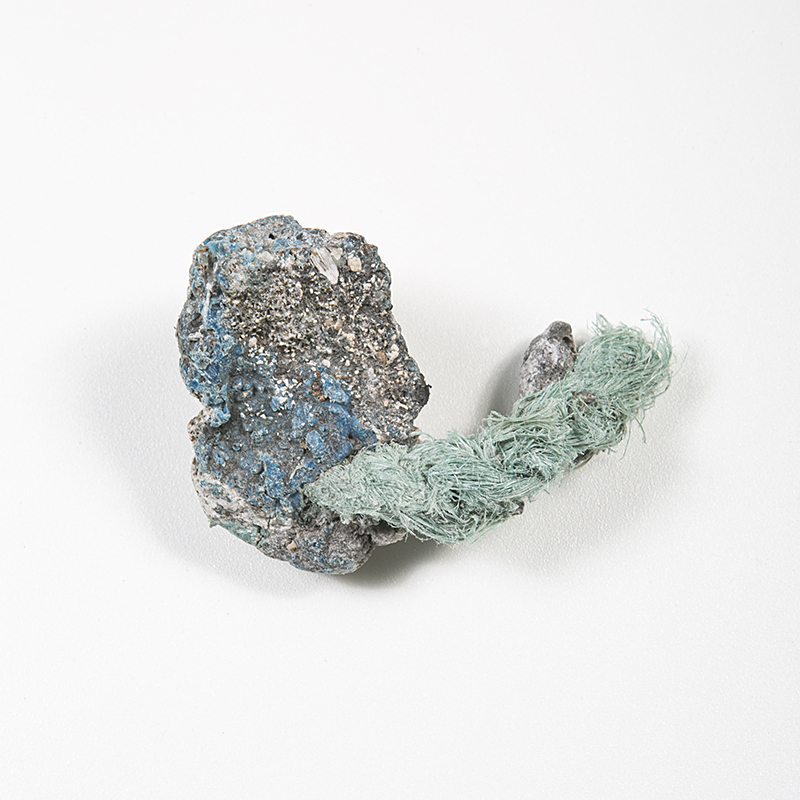
What are the consequences of these findings? And, what cultural role does speculation play? In their 2013 manuscript, the most-viewed article in the history of the journal, Corcoran, Moore and Jazvac argue that plastiglomerate could potentially act as evidence of the Anthropocene era. Popularized by Nobel laureate and atmospheric chemist Paul Crutzen in 2000, the term Anthropocene suggests a profound epochal transformation whereby human beings and their destructive activities have altered Earth’s geology. The term and its legitimacy as a productive concept are widely contested in academia, some researchers going so far as to say it is “more about pop culture than hard science.”8 However, in January 2016 the journal Science published a landmark paper by an international team of Anthropocene researchers, wherein they cite nuclear testing as a key Anthropocene marker, as well as a surge of specific man-made materials in the environment, including concrete, aluminum, and plastic.9
Artists like Jazvac and curators such as Jon Davies, formerly the associate curator of Oakville Galleries, have attempted to theorize the implication of the Anthropocene era in lieu of “hard science.” Davies finds that plastiglomerate speaks to us as persuasive “evidence” of the destructive potential of plastics pollution. Jazvac approaches plastiglomerate under the rubric of the readymade; however, unlike Duchamp’s readymade, which transformed mass-produced consumer products into art as a way to re-conceptualize the very meaning of art itself, Jazvac is interested in questioning the role of plastics pollution in relation to culture at large, it’s the readymade redressed and made anew a century later, but this time it is waste, garbage and detritus that serves as the material. For Jazvac the object’s role as a vehicle for contemplation is precisely where it draws its power:
I found these objects so aesthetic and haunting that I didn’t want to do anything to them; this led to presenting them as found objects. In this role, I like how they use the simple framing device of calling something ‘art’, and all the institutional and historical infrastructure that is bound to that category, as a way to set up an opportunity for new knowledge and thought.10
These objects are unsettling reminders of our present biophysical condition. In Canada alone, detrimental amendments to the Fisheries Act has reduced protection of many fish species, The Navigable Waters Protection Act reduces crucial protection to most lakes and rivers, The Environmental Assessment Act was repealed, and perhaps most embarrassing is Canada’s withdrawal from the Kyoto Agreement after signing the treaty.11 Most recently, Canada has failed to meet its existing target of reducing emissions below 2005 levels while the United States continues to succeed.12
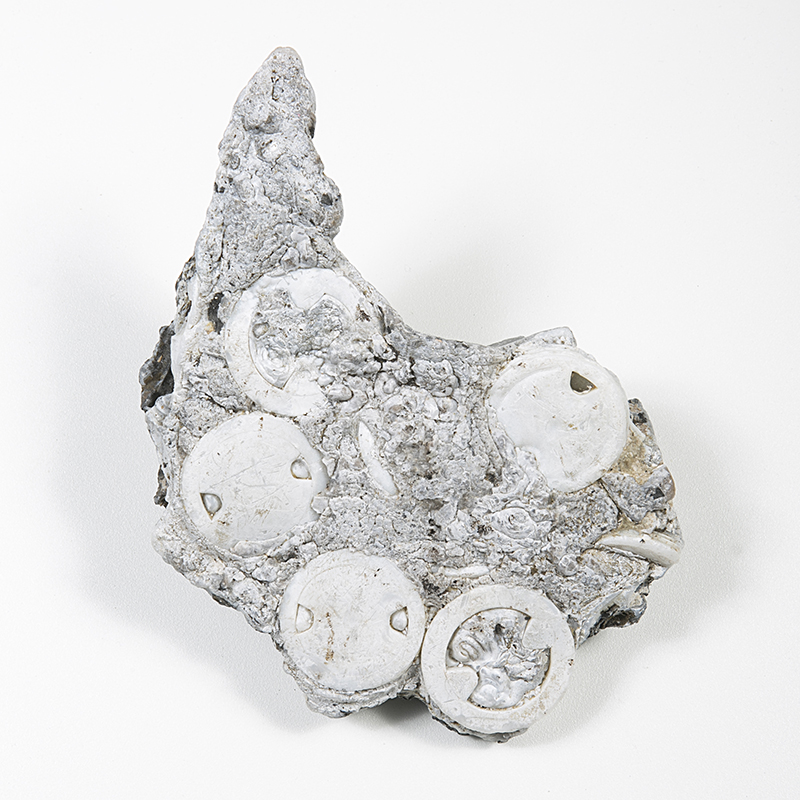
In a different way, Jazvac’s readymade plastiglomerate works are sinister prophesies of apocalyptic futures, and perhaps this is what she means by “haunting.” They are spectres of over-consumption, waste and the accumulation of things. They prey upon the viewer as small metaphors of gluttony; they read as manifestos for irresponsibility. It’s taken a century to see how far we’ve come. Here is the evidence: tangled webs of plastic and stone.
Kelly Jazvac’s Plastiglomerate Samples are currently featured in the exhibition The Future We Remember at the Southeastern Centre for Contemporary Art in North Carolina until June 5, 2016. In August, she sets sail on an expedition of Lake Huron with the largest-to-date, all-woman simultaneous sampling of plastics pollution in the Great Lakes. In October, she will be showing a new, large-scale installation of salvaged billboards at the former site of David Mirvish Books on Art on Markham Street in Toronto. Jazvac has also been long-listed in Ontario for the 2016 Sobey Art Award.
[1] W. G. Sebald, After Nature, trans. Michael Hamburger (New York: Modern Library, 2002), 83.
[2] Marcel Duchamp quoted in Anne Umland and Adrian Sudhalter, Dada in the Collection of the Museum of modern Art (New York: Museum of Modern Art, 2008), 106.
[3] Kelly Jazvac, e-mail communication with the author (20 May, 2015)
[4] Patricia L. Corcoran, Charles J. Moore, and Kelly Jazvac, “An anthropogenic marker horizon in the future rock record,” GSA Today 24.6 (June 2014), 4.
[5] Kelly Jazvac, e-mail communication with the author (20 May, 2015).
[6] Ibid.
[7] Patricia L. Corcoran quoted in Rachel Newer, “Future Fossils: Plastic Stone,” New York Times (9 June 2014), http://www.nytimes.com/2014/06/10/science/earth/future-fossils-plastic-stone.html?_r=0 (accessed 15 May, 2015).
[8] Whitney Autin in Joseph Stromberg, “What is the Anthropocene and Are We in It?” Smithsonian Magazine (January 2013), http://www.smithsonianmag.com/science-nature/what-is-the-anthropocene-and-are-we-in-it-164801414/?no-ist (accessed 20 May, 2015).
[9] Colin N. Waters, Jan Zalasiewicz, Colin Summerhayes, Anthony D. Barnosky, Clement Poirier, Agnieszka Galuszka, Alejandro Cearreta, Matt Edgeworth, Elre C. Ellis, Michael Ellis, Catherine Jeandel, Reinhold Leinfleder, J.R. McNeill, Daniel deB. Richter, WillSteffen, James Syvitski, Davor Vidas, Michale Wagreich, Mark Williams, An Zhisheng, Jacques Greinvald, Eric Odada,Naomi Oreskes, Alexander P. Wolfe, “The Anthropocene is functionall and straigraphically distinct from the Holocene,” Science 08 January 2016. http://science.sciencemag.org/content/351/6269/aad2622
[10] Kelly Jazvac, e-mail communication with the author (20 May, 2015).
[11] Rick Smith, “Stephen Harper: The environment’s best friend,” Toronto Star (31 July, 2015), http://www.thestar.com/opinion/commentary/2014/07/31/stephen_harper_the_environments_best_friend.html (accessed 20 May, 2015).
[12] See Chris Hall, “Stephen Harper draws up election 2015 strategy on climate change” CBC News (20 April, 2015), http://www.cbc.ca/news/politics/stephen-harper-draws-up-election-2015-strategy-on-climate-change-1.3054629 (accessed 20 May, 2015).
Matthew Ryan Smith, Ph.D., is a freelance writer and educator based in London, Ontario, as well as the curator of the Glenhyrst Art Gallery of Brant. He received his Ph.D. in Art and Visual Culture (Curatorial Stream) from the University of Western Ontario in 2012. He is a Sessional Professor of Art History at the University of Toronto, Mississauga and the University of Western Ontario. Matthew has published extensively in exhibition catalogues, art publications and academic journals, most recently “Relational Maneouvres in Autobiographical Video Art” in Biography: An Interdisciplinary Quarterly and “Performative Appropriation of Video Art on YouTube, Vimeo and Dailymotion” in the Journal of Curatorial Studies. He also recently completed a book chapter on unsanctioned graffiti interventions in post-apartheid Johannesburg to be published by the University of Indiana Press.
Charles J. Moore environmentalism found sculpture Jon Davies Kelly Jazvac Marcel Duchamp Patricia Corcoran Plastiglomerate



